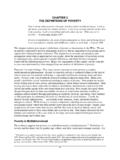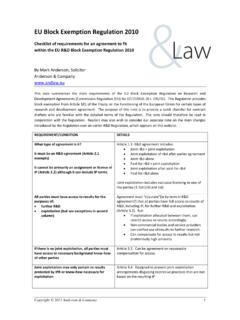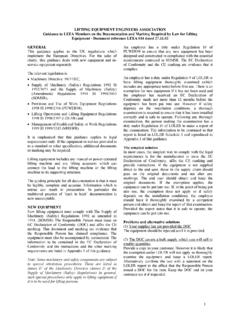Transcription of A Review of the Role and Impact of Export …
1 A Review of the Role and Impact of Export processing zones August 1999. Dorsati Madani Address: PREM- EP. The World Bank EM: CONTENTS: Acknowledgments Disclaimer List of Abbreviations Executive Summary I. Introduction and Definition A. Definition: A1. What are EZPs A2. Characteristics and goals A3. Why do countries use EPZ and EPF schemes? II. The Economic arguments for and against EPZs. A. Foreign exchange earning potential B. Tax revenue/tax loss effects C. FDI: catalyst effects D. FDI: technology transfer, knowledge spillover and backward linkages E. Employment effect on local/national economy F. Women and EPZ employment G. Education/training benefits (human capital development). H. Wages, labor and safety laws I. Environmental issues J. EPZs and the economic and policy environments III. EPZs, Globalization, Regional Integration Agreements and WTO.
2 A. EPZs in the context of regional integration/trade arrangements B. The Uruguay Round, Export subsidies and EPZs IV. The administrative and regulatory environment A. Open or closed production area? B. Location and infrastructure C. Government involvement and institutional needs D. Geographical position of the country and access to international markets E. Summary of practical lessons for a successful zone V. The actual experience: two African cases A. Mauritius B. Senegal 2. VI. Policy Suggestions Annex A: Brief Review of theories regarding EPZs Annex B: Brief notes on some African EPZs. A. Togo B. Namibia C. Kenya D. Cameroon E. Zimbabwe References List of Tables: Table 1: Incentives and provisions offered in EPZs in the Caribbeans and Central America Table 2: Incentives and provisions offered in EPZs in select Sub-Saharan African countries Table 3: Impact of EPZs in select Sub-Saharan African countries Table 4: Impact of EPZs in select countries Table 5a: Industrial concentration of select zones Table 5b: Industrial Concentration of select zones based on percentage of workforce involved in main products lines or provisions of main exports.
3 Table 6: Employment creation in select EPZs Table 7: Central America: Minimum Wage in EPZs and National Minimum (in US dollars), 1995. 3. Acknowledgment The author wishes to extend special thanks to A. L. Winters for his suggestions and assistance throughout the development and completion of this document. The author also thanks W. Martin, J. Emery, , R. Smith, M. Schiff, D. Keesing, P. Blay, J. Hanna, T. Kusago, C. Barham, T. Akiyama, F. Bakoup, N. van Gelder, A. Grudzinska, C. Azi, S. Gray, M. Dorfman, G. Byam, R. Blake, E. Scanteie and G. Pursell, for their contributions during the research and writing of this paper. The author also acknowledges and appreciates comments and suggestions made during the presentation of this paper at the World Bank DEC/RG in February 1998. All remaining errors are those of the author.
4 Disclaimer The findings, interpretations, and conclusions expressed in this paper are entirely those of the author. They do not necessarily represent the views of the World Bank, its Executive Directors, or the countries they represent. The paper should not be quoted or cited without the permission of the author. Acronyms and Abbreviations: EPZ: Export processing Zone EPF: Export processing Firm WTO: World Trade Organization RIA: Regional Integration Agreement RTA: Regional Trade Agreement EU: European Union NAFTA: North-American Free Trade Area OECD: Organization for Economic Cooperation and Development CBI: Caribbean Basin Initiative 4. Executive Summary I. Introduction, Definition, characteristics and goals: Export processing zones (EPZs) have become rather popular trade policy instruments since their modern revival in the late 1950s.
5 While in 1970 only a handful of countries permitted a zone, a recent OECD publication (1996), places the total number of zones at 500 located in 73 countries We define Export processing zones as fenced-in industrial estates specializing in manufacturing for exports that offer firms free trade conditions and a liberal regulatory environment (World Bank, 1992:7). We allow for some domestic sales and include Export processing firms (EPFs)- which benefit from the same EPZ incentives without being fenced in - in our analysis. The primary goals of an Export processing zone are: 1. To provide foreign exchange earnings by promoting non-traditional exports. 2. To provide jobs to alleviate unemployment or under-employment problems in the country and assist in income creation. 3. To attract foreign direct investment (FDI) and engender technological transfer, knowledge spill-over and demonstration effects that would act as catalysts for domestic entrepreneurs to engage in production of non-traditional products.
6 zones share a few common features: 1. Unlimited, duty-free imports of raw, intermediate input and capital goods necessary for the production of exports. 2. Less governmental red-tape. More flexibility with labor laws for the firms in the zone than in the domestic market. 3. Generous and long-term tax holidays and concessions to the firms. 4. Above average (compared to the rest of the host country) communications services and infrastructure. It is also common to for countries to subsidize utilities and rental rates. 5. Zone firms can be domestic, international or joint venture. The role of FDI is prominent in EPZ activities. zones can be categorized into public or private zones (owned or managed), and high- end or low-end. The latter distinction refers to the range of quality of management, facilities and services provided by the zone and therefore, the type of firms populating it.
7 II. A broad brush picture of EPZ experiences: Under propitious circumstances and good management, EPZs generally achieve the two basic goals of creating employment (especially non-traditional employment and income opportunities for women) and increasing foreign earnings. For instance, Mauritius EPZs boasted 71 percent of the nation's gross exports in 1994 and employed percent of the work force. However, some argue that the net foreign earnings may not constitute a large enough sum to warrant the investments undertaken by the country to accommodate a zone. The opportunity 5. costs of such public investments should be considered more closely. Furthermore, there are potential revenue losses from concessions on income taxes and tariffs. EPZs are sensitive to the national economic environment. They will perform better when the country pursues sound macroeconomic and realistic exchange rate policies (Romer, 1993; Alter, 1991).
8 zones may contribute to the building of national human capital in two ways. Previously unskilled workers have benefited from EPZ presence. Their productivity has increased via job training and learning by doing. The benefits of this skill acquisition is limited however, as most production processes are low-skill and low-tech. The most valuable aspect of this type of employment, aside from the income earned, may be the workers' learning of industrial work discipline and routine. Training has also occurred at the supervisory and managerial level, with local employees becoming privy to new organizational and managerial methods, negotiation and marketing skills, general business know-how, foreign contacts and entrepreneurship. In addition, a successful zone, per se, is an efficient and competitive industrial infrastructure.
9 As such it provide the country in which it operates an industrial set-up which it may lacks. Most African nations would fit this profile. There are many cases of catalyst and demonstration effects (Rhee, 1990, Rhee and Belot, 1992) on the host economy. These effects, together with the labor training, may be the zone's lasting contributions to the country in which it operates. Creation of backward linkages seems largely conditional on the industrial base of the nation. In countries which did not already enjoy a solid industrial base and which adopted EPZs to encourage these linkages and foster a domestic industrial base, some linkage occurred, though it was spotty and inconsistent, with firm zones complaining of the poor quality or the incompatibility of local inputs. In countries where a solid industrial base existed prior to the establishment of the EPZs Taiwan and S.
10 Korea- linkages have occurred. The transfer of know-how and technology was facilitated by the existing technological sophistication and highly educated labor force. In these cases, EPZs were only one tool in a panoply of governmental policies to foster economic growth through Export promotion. Even at the height of their influence, EPZs never acquired a prominent role either in terms of exports value or employment creation in S. Korea or Taiwan. Wages in most EPZs are equal or higher than average wages outside the zones . However, there a noted variance around this average. Lax labor, work safety and health laws in many zones have raised concerns with regards to workers' welfare. The size, nationality and corporate policy of the firm, the type of industrial production, labor market conditions and the country's institutions and regulations play a determining role in establishing the wage rate, workers' rights and work environment in EPZs.















